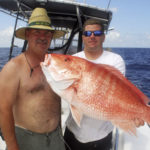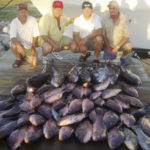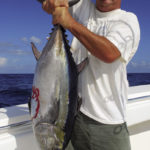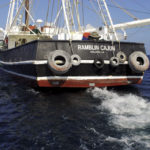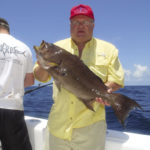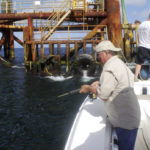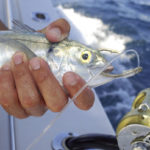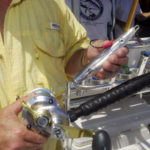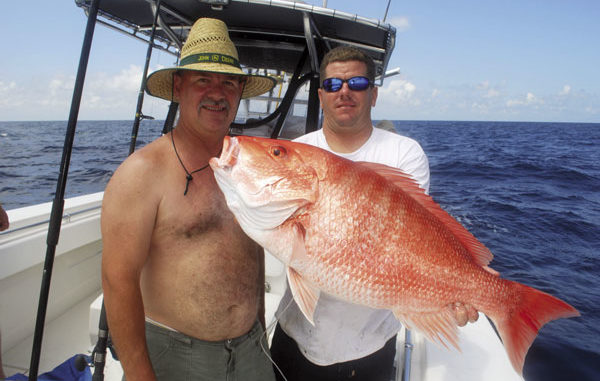
It’s not hard to fill a fish hold with amberjack and a host of other species this month.
The barrel-chested man’s face was florid, and he was sweating profusely. With two hands, he thrust the violently bucking rod into the grip of one of his fishing partners.“I love to jig; I love to hook ’em, not reel ’em in,” he grunted.
He wiped his face on his sleeve and grinned broadly.
Ricky Ruffin was in heaven.
It was supposed to be a grouper trip. After all, Ruffin had just caught the Louisiana state and pending world-record marbled grouper. At the 2009 Louisiana Outdoor Writers Association Convention where he accepted Fish of the Year honors, he said, “I used to do snapper a lot, but now it’s more grouper. I like to eat them — probably my favorite table fish.
“Yes sir, that’s what I fish for — to eat them. That’s why I ate the world record.”
And the guide for the trip that Ruffin arranged for himself and his friends seemed to be a grouper magnet. Ed Frekey of Tuna Time Charters personally held down the second spot for warsaw grouper in Louisiana with a 358-pound fish he caught in 2005. The monster was less than a pound off the state record.
But some inkling of what was going to happen on the trip cropped up the night before when Ruffin peered through his glasses over his plate of Soft-shell Crab Special with Leeville sauce at the Leeville Seafood Restaurant.
“My preference is for amberjacks,” he said. “I would rather catch amberjacks than any other fish offshore — and I strictly fish offshore. And my preference is to catch them on a jig. There ain’t nothing like it when he hits that jig.”
The 55-year old Ruffin, an attorney from Bay Springs, Miss., has been fishing offshore since 1970.
“I fish in Louisiana,” he explained, “because it’s the best fishing in the Gulf. It has all the wells. The more structure to attract fish, the more fish.”
His three partners for the trip all hail from either Bay Springs or other small towns nearby. Fifty-year old Kim Pryor, a contractor and the owner of Shady Rest Wildlife Shooting Preserve, is a former spear-fishing partner of Ruffin’s. His droopy moustache frames a mouth that always seems to be set in a bemused smirk — as if he knows something that no one else does.
Like the other three men, he has a contagious sense of humor and the long slow drawl of native Mississippians that can make the exclamation “dang” into a four-syllable word.
“We are Mississippi rednecks, and this is a meat-gathering trip,” Pryor twanged in reference to their pickup truck outside with its bed solidly filled with ice chests. “It’s the reverse of when Louisiana folks come up to our part of the country deer hunting. They all got a truck load and trailer load of ice chests.”
Shane Cook, the youngest of the four at 36, has been Ruffin’s most regular fishing partner since 2006. Tall and blue-eyed, he has the look of a country boy, but also owns his own contracting business.
A little quieter than Pryor or the bonhomous Ruffin, he commented, “I like to catch fish more than I like to cook them. I can’t cook like Ricky, but I like to eat his cooking.”
The final man in the quartet, 63-year old Ronnie Walters, a neighbor of Cook’s, is on his first trip with Ruffin. With his chiseled features and sun-tanned skin, he has the classic outdoorsman’s look. Although he owns a factory that manufactures ATV accessories in Mississippi, he spends as much time as he can at his Grand Isle camp, mainly fishing for trout and redfish.
The creeping dawn of the next morning found Frekey’s sleek, stiletto-shaped 33-foot Contender slipping by cumbersome oilfield work boats in Port Fourchon. Once outside the pass, the boat streaked across the chop toward the southwest, toward South Timbalier, 46 miles away. Ahead, towering cumulonimbus clouds were making up.
Before reaching his first fishing destination, Frekey stopped the boat at a solitary well guard to catch hardtails, preferred baitfish for both grouper and amberjack fishing. Ruffin watched Frekey’s two deckhands, Neal Toups and Paul Ledet, catch hardtail after hardtail on tiny sabiki rigs. Finally, he couldn’t take it any more, grabbed a rod rigged with a curl-tail grub and began jigging frenetically, hoping for a lemonfish.
Instead, he was rewarded with a respectable 12-pound-plus red snapper. Before he could drop the bait back down, the live-well had as many hardtails in it as Frekey thought they would need, and he charged the boat off like a greyhound toward South Timbalier Block 200.
But things were slow there. Three stops at three platforms yielded only one more big red snapper to the men’s offerings of curl-tail grubs, butterfly jigs and live hardtails.
The terminal tackle that Frekey used for fishing with the live hardtails was pretty typical for live-bait fishing in deep water — a 20- to 40-ounce ball weight over a swivel. Below the swivel was a 5-foot, 200-pound-test monofilament leader with a 14/0 to 16/0 circle hook on its business end. Invariably, the men hooked the hardtails through the upper jaw.
When the boat reached a target platform, Frekey circled it, carefully watching his electronic fish finder for signs of amberjack suspended off the bottom. If he marked fish, some of the men dropped baits to the depth indicated on the machine, while others went to the bottom looking for grouper.
Spying a shrimp trawler working in the near distance, Frekey opted for a short-term change of tactics to try to pick up a lemonfish. He piloted the sportfisher right up into the wheel wash of the big trawler, and held it there while Ledet broke thawed Spanish sardines in two and pitched them near the stern of the trawler.
Immediately, two blackfin tuna broke out from beneath the vessel to grab the chummed sardines. One was surprised to find a piece with a hook buried in it. Pryor welcomed it onto the boat after a vigorous tussle.
Back to hunting for grouper.
Next stop was a big platform in Block 300 of South Timbalier. Frekey didn’t mark any fish in the milky-blue water, so Ledet and Toups dropped live hardtails to the bottom looking for grouper.
Ruffin dropped his favorite lure, a butterfly jig, and began jigging like crazy. Walters followed with a diamond jig, and Cook and Pryor each put curl-tail grubs to work. While the men worked their jigs, Frekey jockeyed the boat’s engines to keep the boat in one position near the rig.
First Cook hooked up with a good amberjack, followed by Walters, Ruffin and then Pryor. All four men boated AJs in the 35- to 40-pound range. Just like that, they filled their one-amberjack-per-man limit. Nothing touched the live hardtails.
The men decided to concentrate on groupers for a few hours before heading for shallower water to catch some mangrove snapper. On the way to the next platform, Frekey talked about targeting grouper.
“It’s not really a big science,” he said. “You fish in the right depth, 200 feet or more, use heavy weights, heavy leaders and fish on the bottom. People try to make too much out of it. It is really about getting to where they live.
“It isn’t a fast fishery. It demands patience. It’s a fish here and a fish there. You have to move from place to place.”
The next platform was in azure blue water, 400 feet deep, also in South Timbalier. Ruffin was still fresh and set a blazing pace with his almost frenetic jigging. Frekey rigged a rod with a specially prepared hardtail that had its backbone filleted out. The butterflied and bloodied bait was supposed to be especially tempting for grouper.
Ruffin’s hard jigging paid off with a keeper scamp, the first grouper of the day. The rig yielded little else besides three small but legal almaco jacks.
Hunting for grouper, Frekey moved to a platform in 450 feet of water, still in South Timbalier. Nothing even looked at the hardtails on the men’s hooks, but amberjacks in the low 40-pound range ate up the men’s jigs. After landing and releasing a dozen of the hard-hitting sluggers, Frekey moved again.
The next platform, also at 450 feet deep, produced an even more steady diet of amberjacks. A move back to 400 feet produced more AJs. One of the Mississippians called the platform “… ate up with ’em.”
Two and three at a time were coming over the side. Someone’s jig was almost always hooked up to a 40-pound amberjack. Here, Ruffin’s butterfly jig produced the second and last grouper of the trip, another broom-tailed scamp.
“This is unbelievable, said Ruffin in awe. “Amberjacks certainly aren’t in any biological trouble.”
Frekey looked on and shook his head.
“There are days when I’d give anything to get an amberjack in the boat,” he said. “Today, there are too many of them.”
Finally, they give up on grouper, and Frekey turned the boat northwestward to head for Ship Shoal and hopefully some mangrove snapper.
They tied the boat off to a platform in 175 feet of water, and Frekey climbed up on the bow with a plastic bucket holding Spanish sardines. He broke the small fish into pieces, and tossed them toward one of the legs of the platform, hoping to lure mangrove snapper out into the open. The three anglers watched him and the water in anticipation.
“It is lousy with them down there,” Frekey said.
That sent the men scrambling for their lighter spinning rods. Ledet and Toups baited the lines by burying the hooks inside the bodies of Spanish sardines.
Their rigs were simple — single hooks on a monofilament shock leader. No weight was used because it was important that the hook-bearing sardines drifted as naturally as the chum pieces that Frekey was feeding to the fish. Anything that interfered with the natural drift of the bait would cause the wily mangrove snapper to turn their noses up at the offering.
One man stood inside the boat on each side of Frekey. Each tossed his hook-sweetened morsel to the fish gobbling up the chum that Frekey was giving them. As soon as one man would hook up, he would walk toward the back of the boat to get the fish away from the platform’s barnacle-covered legs, and the next angler would take his place.
The stop produced eight mangrove snapper between 1½ and 5 pounds before the fish got wise and wouldn’t rise to the chum. Ruffin explained that this is normal and that sight fishing for mangroves involves a lot of moves.
The next rig was in shallower water, 150 feet deep. The routine was the same, but they took only four mangrove snapper. Before they left, Pryor dropped a grouper jig overboard, and promptly boated a red snapper pushing 20 pounds.
Frekey took the men back to South Timbalier to a platform in 150 feet of water. No mangroves came out to gobble the chum — nothing.
Next stop was a South Timbalier rig in only 130 feet of water. Frekey climbed up on the bow with his chum bucket, and started tossing chum toward one rig leg. Mangroves snapper swarmed out like piranha.
Not only were the fish plentiful and aggressive, many of them were big too, some up to 8 pounds. The copper-colored beauties came on board faster then the two deck hands could ice them, and soon fish bodies were lying all over the deck.
The nonstop action soon produced the 28 mangrove snapper that filled their 10-fish-per-person limit.
The four anglers finally put their weapons down. They sat for a moment on the boat’s gunnels, sipped water and silently reflected in lengthening rays of the evening sun.
Cook broke the silence: “That sure was good. It was like being on a good bream bed.”
